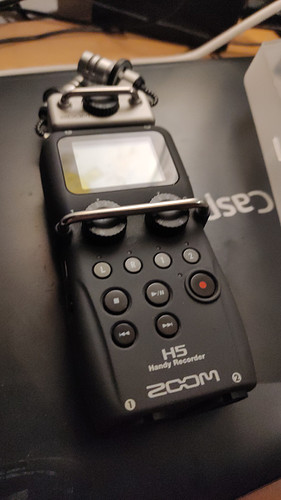Hello everyone,
I have been searching for different ways to record mainly audio but also videos at our band practices. Recently I have been playing with two bands with similar configurations. It is usually an acoustic drum set, vocalist connected to a mixer, one electric guitar and one bas guitar with their own amps.
On one of the groups there is a second guitar (classical with integrated preamp) that also connects directly to the mixer.
So vocals (and second classical guitar) is coming through big monitors while the bass, electric guitar and drum set are their own sound sources.
This is the studio that we are using with the 5 people band:
My initial approach was the simplest which was pressing record on my smartphone which was near me (so near to the bass amp as well) :
Here is how it came out.
It was quite indicative on many occasions but but the input gain was not easy to set and over all sound quality drops significantly. Furthermore I had the intention to use my phone for recording video as well and the right position to record video is not always the best for audio…
So I have switched to another method where I tried to connect everyone through a mixer to my two channel audio interface ( Motu M2 ). The challenge here was to mic the drums properly but all I had were two dynamic microphones one over head one kissing the kick drums. Bass and electric guitar were going direct in. Motu M2 was connected to my phone through USB so I could record videos already…
This is a snippet of that night… Personally it was horrible. It took ages to cable everything and I did not have the time and patience of my band mates to set the mix properly. In the end the drums and bass simply were too low while the vocal and the guitar was quite clear. In any case this gave us a great indication on what quality we could achive.
Finally after a long research and some input from one of the drummers I decided to go for a field recorder.
Among many other videos on topic this was the most inspiring:
I was also going for an H1n myself (there was one for 50€ if I waited a month and 85€ brand new) but just before I was about to purchase a new one a notification for a second hand site informed me a much superior recorder announcement dropped in. Which I literally jumped on…
This thing must be the epitome of mobile recording! It has the amazing two condenser mics which were already fine to take care of what I needed initially but there are all these integrated features which makes it crazy good:
- Line out to connect to a camera or phone for video recording
- Two XLR combo inputs if I want to connect the guitars
- Two mic capsule can be replaced with other types of mics and/or an extension device which brings two more XLR combo jacks.
- This mic capsule also has an input for a stereo input either for line in or mic which I can connect the guitar and bass direct outs or the mixer output if necessary.
- You set all the levels on the device itself to match the maximum input to -12dB and even then you can record a secondary backup file which is 12dB lower incase something clips.
- There is a USB port to connect to PC which can also work as an audio interface!
- When you connect line out to your phone to record videos you can also record on the device at the same time.
- It works on two AA batteries and can record for 5-6 hours like that (specs)
All and all the possibilities become infinite with this thing!
This is the recording with the 5 people band in the big studio that I also shared in the mic thread
Here I intuitively setup the gain depending on the drum set and told everyone else to set their volumes accordingly so that I can get -12dB but after a couple of songs everything went about all over the place. While playing I was not able to hear my bass anymore but on the recording it is loud and clear (probably the wavelength thing where you hear the bass better when you are 6m away )
The recorder was on a small stand on the bar table on the left just from the entrance (you can see it on the video). It was directed towards the drums.
I have ordered a mic stand adapter (it has a camera type of screw under it ) so That I can fix it somewhere else…



